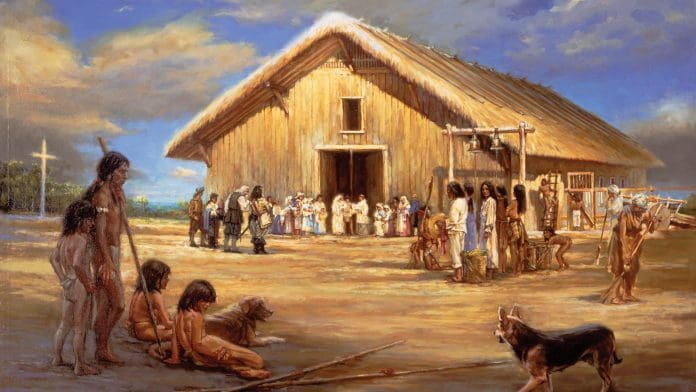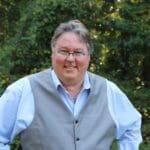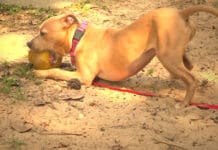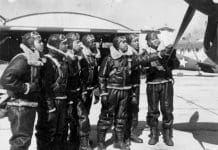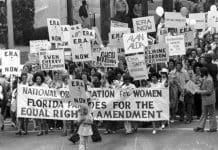Series Producers: Suzanne Smith, Mike Plummer, Rob Diaz de Villegas
Follow the footsteps of the men and women who created what we know today as the Sunshine State
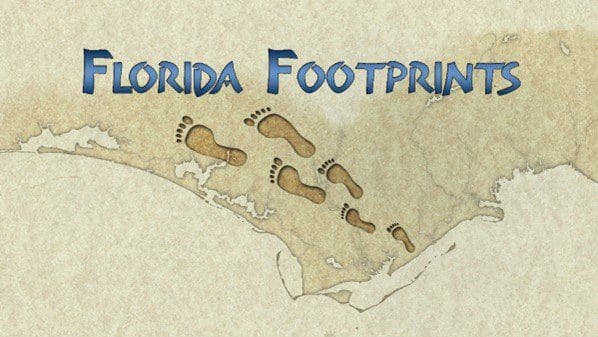

It has been more than 500 years since Juan Ponce de Leon first landed on the shores of La Florida. In 2012, WFSU Public Media began to explore the history of the North Florida during those five centuries for a special project. The end result was a 7-part documentary series called Florida Footprints and it focuses on the history of the Big Bend and Panhandle area. All of these documentaries are available for streaming on WFSU Passport. You can also watch them below. Watch in order or pick the time period that interests YOU.
Episode 1– Once Upon Anhaica (1513-1704)
Before there was Tallahassee, there was Anhaica. This WFSU-TV documentary looks at the Big Bend area when the first European explorers arrived at Anhaica, the capital of the Apalachee people. From the culture of the Apalachee to the creation of Spanish missions to the community we know today, it all began “Once upon Anhaica”.
Once Upon Anhaica, WFSU Public Media, Copyright 2012
Episode 2 – A Feral Land (1704-1845)
By the 18th and 19th centuries, Northwest Florida had been known to the Europeans for hundreds of years, but this area was far from tame. Spanish, French, British, American and Native Americans fight for control over “A Feral Land” once known as La Florida. In the second of our ongoing documentary series, we explore the political, personal and physical battles in the area following the fall of the Spanish missions.
A Feral Land, WFSU Public Media, Copyright 2012
Episode 3 – The Confederate Road (1845-1865)
Plantations, cotton and slavery were a big part of middle Florida’s economy by 1860 and the election of a new President challenged that lifestyle. Florida Footprints follows the path the state took once it chose to march down “The Confederate Road.” From slavery and plantations to salt making and soldiers, we explore the skirmishes, battles, and life in Florida during the Civil War.
The Confederate Road, WFSU Public Media, Copyright 2013
Episode 4 – A State of Change (1865-1918)
This episode explores the history of the Big Bend and Panhandle area as Florida transitions through the uncertain times of Reconstruction following the Civil War into the rapidly changing world of the 20th century.
A State of Change, WFSU Public Media, Copyright 2013
Episode 5 – A Patchwork Panhandle (1918-1945)
In “A Patchwork Panhandle,” WFSU-TV stitches together a variety of stories that happened within our viewing area during the 1920s, ‘30s and ‘40s. From Prohibition and moonshine to New Deal work projects we explore the economic and social changes coming to the area. Plus, the rise of World War II training sites at the airfields and on the shores of the Big Bend that left a lasting impact.
A Patchwork Panhandle, WFSU Public Media, Copyright 2013
Episode 6 – The Paths of Progress (1945-1975)
Following World War II, progress in North Central Florida takes several paths. It begins with a population explosion that has consequences on the economy and education. New highways and interstates are developed to improve transportation and tourism. And as civil rights issues and opposition to the war in Vietnam gain traction across the country, the city of Tallahassee and its two state universities become a hub for boycotts and protests.
The Paths of Progress, WFSU Public Media, Copyright 2013
Episode 7– Florida Ever After (1975- 2013)
North Central Florida emerges as the place we know today. Changes in the region’s economy, society and landscape accelerate. This time period is not without challenges: A college campus deals with the devastation left behind by serial killer Ted Bundy; the outcome of a presidential election hinges on what happens in the state’s capital; and concern about the area’s natural resources becomes a source for political and public disagreement. Each new event springing in some way from other events of the past. And this history will continue to influence “Florida Ever After.”
Florida Ever After, WFSU Public Media, Copyright 2014

